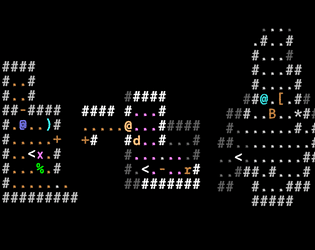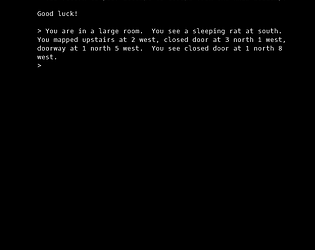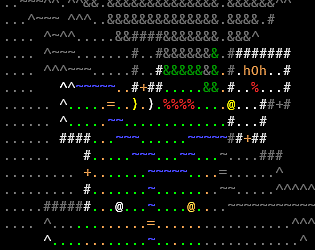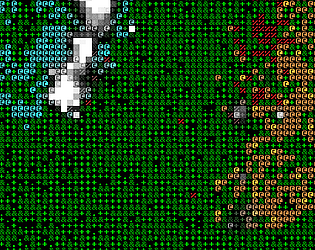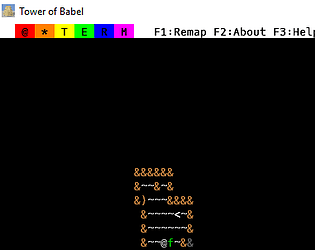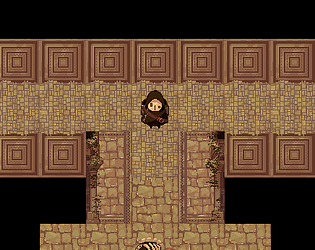Thank you for taking considerable time to try out Pointless.
After spending scores of hours making this, it is nice to see that you were willing to give it a serious try.
Pointless, as mentioned in the game design message you read, has a strong artistic statement behind it. It is designed to be an attack on the Achiever-focused nature of modern video games. It seems to have been rather successful in your case, as your final conclusion was that the game doesn't give you any shiny bread crumbs, so is pointless? But I sort of hoped Achiever-focused players would break out of that loop and discover the joy of being an Explorer instead. There is a LOT in Pointless for the explorer. The trick is you have to set your own goals and plans. The game won't tell you "why" you should do anything. There are no "Steam Achivement" badges when you trigger strange edge conditions - you are expected to generate that reward internally.
So, like all of my art-focused 7DRLs, I'm left with a strange juxtaposition of success and failure. I've successfully cutaway the "gameplay loop" achiever playstyle without actually removing any of the actual content (as I could have easily added hand-holding to lead you down a garden path to kill Ba'zlbub - the choice of dropping you randomly on a 1km island is not some accidental mistake on my part; but an intentional device to erase such a path!); but I've not managed to communicate the actual goal to the sort of player I had hoped to reveal another way of enjoying video games. Normally I just assume people haven't read the README, but I saw you read it, so this failure to communicate is in my court. I'll have to take solace on the thesis of Omniscient Readers Viewpoint and just continue to write on my side of the wall, however. Even though you will not read it; I will have written it.
I've carefully watched your playthrough and made notes. It is always instructive to be able to sit over someones shoulder as they puzzle things out; so thank you for giving me this opportunity.
While not every game is for everyone; I want the barrier to be personal preference, not bad UI or cryptic controls. Thus the 12 minutes of text on gameplay and gamedesign you found. I don't really expect everyone to read all of it, more to go to it if they are confused, or are very new to the genre.
My first concern is people find the pop-up menus. This is something I default off, which is arguably a bad idea as novice users would be better suited to having it on. But after adding keyboard controls to MAGE I was astonished how much more fluid they are than navigating menus (despite my menus having extensive keyboard shortcuts within them!), so have been obstinately defaulting to keyboard, hoping people can find the bread crumbs to turn it on if it offends them. I was glad to see you did find them, even though that caused its own problems...
Full screen is another option that I've changed over the years. I was default full screen for a while; but it is very disruptive to grab the entire monitor on launch (I had one review ding me for just this one year!). It also is a bit of a mixed bag in Windows - you can see your own recording switched to 1/2 size as you aren't running 100% DPI. But maybe this justifies the keyboard choice as to adjust that, you also will find the full screen command.
There are two opaque choices there, however, Verbose Messages and Wall Sliding. Wall sliding dates back to Jacob's Matrix. When on, if something blocks your way to the east, you will possibly move north-east or south-east rather than just stopping. This makes it painless to navigate twisting corridors that otherwise require constantly switching your direction keys. However, if you are trying to play with the message stream rather than the map, this will result in unexpected motion. So for accessibility in addition to personal preference there is a choice to disable it.
Verbose messages is similar. If enabled, it will describe every square you step on, not just interesting ones. It also will do chamber scans to report monsters around you so you don't have to screen-read the map. This is what caused the crash - I forgot to build without asserts, and as there are no chambers in the overworld, it was asserting an invalid chamber name and crashing. So if you should ever want to play again, when you turn on pop-up menus please do not turn on verbose messages, at least until I have an update. Verbose messages is also why you were being spammed with updates on the overworld.
I've also made a note to add help to the options so these don't become blind choices.
Thankfully you persevered, and in the succeeding playthrough didn't turn on verbose messages, so could play crash-free until you were defeated by existential anguish :>
Now, if I were to list my desires for players to find, it was:
a) Pop-up menus
b) How to harvest trees (as this is non-standard)
c) How to make a fire to stay warm
d) That there is something interesting in the central mountains
(a) seems sign posted enough. (d) is addressed partly by dying - you can always roll a life that starts in the foothills, as you did the second play through, and then see the flint deposits and caves.
(b) seemed pretty fast, which is fortunate. I got a bit worried about the campfire (c) as you were playing with clubs for a bit, but it all seemed to have clicked within three minutes. So at this point I had high hopes you would start to look for your own source of dopamine.
To make an analogy to Minecraft, there is a hard-barrier to figure out things like punching trees; and building a pickaxe; to be able to progress anywhere. At a point you can let the player follow their own discovery pattern; but the first steps are essential. I was impressed to see (a)pplying torches also came naturally, now I just had to wait for you to survive to nightfall to see their use....
At this point you wandered away from the campfire and wondered where you were. You are somewhere on a 1km by 1km island, so I really have no idea where you are either. It is a VERY big map. (But you also do not need to wander aimlessly...)
But now we get to the interesting bit... You start to shiver. Then freeze. But lighting a fire always seems to be an after thought? Probably you want to start the fire before you are half dead? You guess right that freezing consumes food - in particular, at the shivering level you metabolism is raised to stop you from freezing in exchange for emptying your energy reserves.
Keep in mind that you are walking naked through deep snow in the winter. Maybe being from a cold climate makes these things more obvious to me; but it never occurred to me to telegraph that if you keep freezing to death, you probably want to stick near campfires or light new ones when cold?
I am glad you noticed the loss of toes, though. Hopefully I get some points for innovation for detailed snow shovelling, melting, and toe-loss technology :>
This pattern repeats; including a death when mobbed by coyotes. We then get an epic moment that I really had hoped would turn things around. Facing a pair of ravenous coyotes inbound, you had given up on life. But some last bit of bravado inspires you to fashion an club out of a stick and attack back - with success! No longer a passive agent in the world; perhaps now you'll build a hunter role for yourself?
It seems it is not to be - running naked through the snow you repeat the pattern of freezing to death, lighting campfires too late and wandering away from them before fully warmed.... :< I did appreciate you almost got a forest fire going, I had to do some serious optimization to deal with the number light sources those can trigger!
I was happy to see you try out the lenses. I think they are a rather cool way to try and bring more data into the roguelike without overloading the normal view. The elevation one is useful if you want to seek the caves - they are at the center, so you need to find a way upwards. The snow depth is not a simple function of elevation - there is a snow fall and drift model during world generation to set the snow depth. This is mostly a pointless window into that mechanic; but also can be useful as you can see places you've carved out by shoveling or melted with your fires. Unfortunately you didn't try the third lens, the resource lens. This was part of the attempt to address (b) by making "harvestable" tiles clear to the player. Reeds, in particular, are harvestable, and are one of the key ingredients in the overworld builds. I had hoped the F4 lens would draw people to them if they didn't see them on the make menu. As for the make menu, as you point out it is useful to see all makeables, not just the reduce list currently available. This is done with *. With all inventory lists ? lists the "usable" choices and * lists all choices. If pop-ups were enabled, there's also a separate "Show All" entry to lead you to this.
I find it interesting that you criticize the speed at which you die. This is not accidental. You are not expected to figure things out in one play through in a roguelike. You are expected to learn from your deaths and figure out over many play throughs. "Keeping warm" is the first step if you want to survive, and if cold didn't kill you fast enough, it would take too long to figure that out. Allowing you to wander in circles longer before freezing to death would give you fewer iterations to realize that running naked through snow was a bad idea. A quick death loop is a wall to flag you've got something to surmount. I just spent 30 minutes re-fighting the same monster in Clare Obscura as I slowly honed my skills. A fast death loop there was essential so I could try again. Likewise, the death loop you experienced was tweaked specifically to trigger a similar sort of re-think.
Thank you again for spending the time on this, and I hope you do not mind this wall of text as a reply.




